/Vehicles/Axis/Germany/01-lePanzers/PzKpfw1/File/4-Conversions.htm | Last Up-date: 10-02-2022
Panzerkampfwagen II Light Tank
Conversions
Flammpanzer II 'Flamingo'
Début 1939, le quartier général de l'armée de terre (Heer) commanda le développement d'un char lance-flammes (Flammpanzer) sur base du Pz.Kpfw II. MAN et Daimler-Benz furent invité à travailler sur le projet. En juillet 1939, un prototype basé sur le Pz.Kpfw II Ausf.D/E fut construit. Il était armé de deux projecteurs montés sur de mini-tourelles (Spitzkopfe) installées à l'avant des garde-boue. Cet tourelle pouvaient opérer dans un champ de 180°. Deux réservoirs de 160 l permettant 80 tirs d'une portée utile de 25 mm furent installés sur les côtés. Le liquide inflammable était composé d'une mixture faite d'huile et d'essence qui était enflammée via du nitrogène pressurisé contenu dans six réservoirs pressurisés. Le projecteur était mis à feu au moyen d'un lighter l'acétylène. Comme armement secondaire, le Flammpanzer II disposait d'une MG 34 de 7.92 mm (1800 coups) montée sur une petite tourelle spéciale (Kugelblende) . L'équipage était composé de trois hommes: le commandant-opérateur des lance-flammes, l'opérateur radio et le pilote. Le blindage était épais à l'avant de 30 mm et de 14.5 mm sur les autres côtés. Il était propulsé par un 6 cylindres (essence) Maybach HL 62TRM développant 140 cv.
At the beginning of 1939, the headquarters of the Army (Heer) ordered the development of a flame thrower tank (Flammpanzer) on the basis of Pz.Kpfw II. MAN and Daimler-Benz was invited to work on the project. In July 1939, a prototype based on Pz.Kpfw II Ausf.D/E was built. It was armed with two projectors assembled on mini-turrets (Spitzkopfe) installed on the front of the mudguards. This turret could operate in a field of 180°. Two tanks of 160 L allowing 80 shootings with a useful range of 25 mm were installed on the sides. The flammable liquid was composed of a gasoline and oil mixture which was ignited via pressurized nitrogen contained in six pressurized tanks. The projector was fired by means of an acetylene lighter. Like secondary armament, Flammpanzer II laid out of a MG 34 of 7.92 mm (1800 rounds) mounted on a small special turret (Kugelblende). The crew was composed of three men: the commander-operator of the flame throwers, the radio operator and the pilot. The shielding was thick in front of 30 mm and 14.5 mm on the other sides. It was propelled by one 6 cylinders (gasoline) Maybach HL 62TRM developing 140 hp.
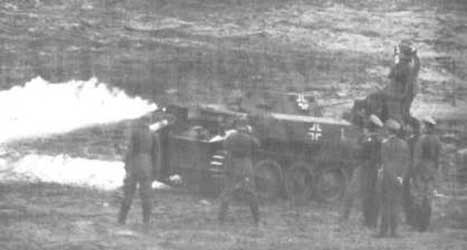 |
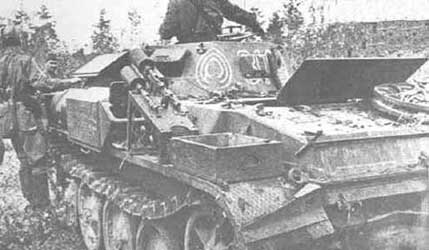 |
Flammpanzer II
|
|
src: Site
Lexikon
der Wehrmacht
|
src: site
Photos
Gallery of WW2 |
MAN en produira 46 châssis entre avril et septembre 1939 qui seront convertis en Flammpanzers par Wegmann. Les conversions débuteront en janvier 1940. En mars 1940, 30 Pz.Kpfw II Ausf.D/E seront retirés des 7e et 8e Panzerdivisions pour être convertis en Flammpanzers. En tout 90 Flammpanzers II furent produits entre mai et décembre 1940. En mars 1940, une commande de 150 exemplaires sera effectuée mais seulement 90 nouveaux Flammpanzers II seront effectivement produits jusqu'en août 1941. Le reste sera réalisé à partir de Pz.kpfw II Ausf.D retirés du front. En décembre 1941, il fut ordonner que 90 Flammpanzers II fussent complétés pour servir de base à des chasseurs de char Marder II.
Les Flammpanzers II étaient avant tout des armes d'appui pour l'infanterie. Les Flammpanzers II furent versés dans les Panzerabteilung (F) 100 und 101. Le 100 fut attaché à la 18e Pz.Division et le 101 à la 7e Pz.Division durant l'opération Barbarossa. Ils resteront en service sur le front russe jusqu'en fin 1941. Les Flammpanzers II survivants seront convertis en Marder II. Notons que des tourelles de Flammpanzers II convertis furent utilisés sur les fortifications en Norvège.
MAN produced of them 46 chassis between April and September 1939 which will be converted into Flammpanzers by Wegmann. Conversions will begin in January 1940. In March 1940, 30 Pz.Kpfw II Ausf.D/E will be withdrawn from 7th and 8th Panzerdivisions to be converted into Flammpanzers. In all 90 Flammpanzers II were produced between May and December 1940. In March 1940, an order of 150 specimens will be carried out but only 90 new Flammpanzers II will be actually produced until August 1941. The remainder will be carried out starting from Pz.kpfw II Ausf.D withdrawn from the front. In December 1941, it was to order that 90 Flammpanzers II were supplemented to be used as a basis for hunters of tank Marder II.
Flammpanzers II were above all the weapons of support for the infantry. Flammpanzers II were versed in Panzerabteilung (F) 100 und 101. The 100 was attached to 18th Pz.Division and the 101 in 7th Pz.Division during the Barbarossa operation. They will remain in service on the Russian front until the end of 1941. Flammpanzers II survivors will be converted into Marder II. Note that converted turrets of Flammpanzers II were used on the fortifications in Norway.
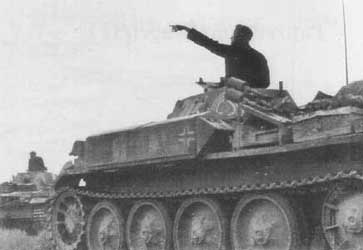 |
Flammpanzer
II |
src:
Panzer II - Horst Scheibert, Schiffer Military History |
Data |
Drawings |
VK 1602 Leopard
Comme le Panzer II n'était plus compatible avec un rôle de char de combat dès 1941, on mit sur pied divers projets de chars de reconnaissance basé sur le châssis du Pz.Kpfw II. En mars 1942, MIAG reçurent l'ordre de concevoir un char de reconnaissance mi-lourd capable d'opérer dans des conditions de combat (gefechtsaufklarung). MIAG devait concevoir le châssis et Daimler-Benz la tourelle pour octobre 1942, début de la production. Cet engin était destiné au section de commandement (QG) des unités de Panzers. En fait deux versions furent proposées: une légère (leichte) de 18 tonnes et une lourde (schwere) de 26 tonnes. La version légère fut abandonnée dès l'été 1942 et tous les efforts furent portés sur le développement de la version lourde désignée VK 1602 ou Leopard. Le VK 1602 découlait de projets antérieurs, le VK 1601 ou PZ.Kpfw II Ausf.J (22 exemplaires produits) et le VK 1301 ou Pz.Kpfw II Ausf.M. Cependant, ce nouveau design n'avait que peu de ressemblance extérieur avec le Panzer II mais ressemblait surtout à un petit Panther (Pz.Kpfw V) qui était en cours de développement. La suspension était composée de grands galets entrelacés comme sur le PZ.Kpfw II Ausf.L Luchs (Lynx) dont il devait en principe prendre la place. Un maquette fut réalisée pour mai-juin 1942 et le premier prototype devait être complété pour septembre 1942 alors que la production devait finalement débuter en avril 1943.
As Panzer II was not compatible any more with a role of battle tank since 1941, one set up various projects of tanks of reconnaissance based on the chassis of Pz.Kpfw II. In March 1942, MIAG accepted the order to design a medium-heavy tank of reconnaissance able to operate under conditions of combat (gefechtsaufklarung). MIAG was to design the chassis and Daimler-Benz the turret for October 1942, beginning of the production. This machine was intended for the section of command (HQ) of the units of Panzers. In fact two versions were proposed: light (leichte) of 18 tons and heavy (schwere) of 26 tons. The light version was abandoned in the summer 1942 and all efforts were related to the development of the heavy version indicated VK 1602 or Leopard. The VK 1602 rose from former projects, the VK 1601 or PZ.Kpfw II Ausf.J (22 produced specimens) and the VK 1301 or Pz.Kpfw II Ausf.M. However, this new design had only little resemblance outside to Panzer II but resembled especially a small Panther (Pz.Kpfw V) which was under development. The suspension was made up of large interlaced road wheels as on PZ.Kpfw II Ausf.L Luchs (Lynx) of which it was to take the place in theory. A model was produced for May-June 1942 and the first prototype was to be completed for September 1942 whereas the production was to finally begin in April 1943.
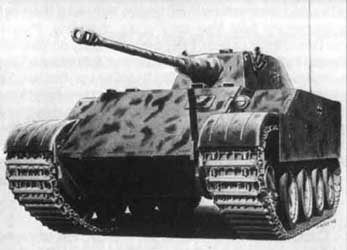 |
VK 1602 Leopard
|
src: Site
"Panzerwaffe"
|
Le Leopard devait être armé du 50 mm KwK 39/1 L/60 similaire à celui du Pz.Kpfw III et d'une mitrailleuse de 7.92 mm MG 34/42 montés sur une petite tourelle nouvellement conçue. Celle-ci devait toutefois être capable d'accueillir un canon de 75 mm KwK 41. Le VK 1602 était doté d'un blindage frontal de 80 mm constitué de parois inclinées alors que les côtés étaient verticaux et épais de seulement 20 mm. Le moteur devait être le Maybach HL 157P développant 550 cv ce qui aurait permit au Leopard d'atteindre sur route les 50-60 km/h. Pour faciliter les manoeuvres en tout terrain des chenilles de 350 mm de large devaient être utilisées. L'équipage devait être composé de 4 hommes. Ce char de reconnaissance qui faisait partie du Panzerprogramm 41 devait en principe être construit à 339 exemplaires mais le projet fut annulé en janvier 1943 alors qu'aucun prototype n'avait encore été complété. Les raisons de cet annulation était que le Leopard était trop lourd et trop peu armé et qu'étant similaire au Panther, ce dernier entrait en concurrence avec lui pour des missions de reconnaissance. En effet il semblait plus pertinent de développer une version de reconnaissance du Panther moins coûteuse à réaliser. Daimler-Benz proposa encore un autre projet de char de reconnaissance rapide, le VK 2801 mais celui-ci ne fut jamais réalisé lorsque que le programme en entier fut annulé en mai 1944. Le VK 2801 devait être propulsé par une Maybach HL230 développant 700 cv. S'en était fini des chars de reconnaissance spéciaux, cette tâche sera dévolue maintenant aux Panthers et Panzers IV. Notons que la tourelle de Daimler-Benz avait déjà été pré-produite et que les exemplaires réalisés seront montés sur les auto-blindées à 8 roues Sd.Kfz.234/2 baptisées Pumas. Un waffenträger (porteur d'arme) basé sur le Leopard fut imaginé par Rheinmetall avec le l'obusier léger de 105 mm mais seule une maquette en bois fut réalisée. Une version antiaérienne fut également imaginée armée du 20 mm Flakvierling ou du 37 mm Flak 36 mais comme le Leopard, ne fut jamais finalisée.
Leopard was to be armed with the 50 mm KwK 39/1 L/60 similar to that of Pz.Kpfw III and a machine-gun of 7.92 mm MG 34/42 assembled on a small lately designed turret. This one was however to be able to accomodate a gun of 75 mm KwK 41. The VK 1602 was equipped with a frontal shielding of 80 mm made up of tilted walls whereas the sides were vertical and thick of only 20 mm. The engine was to be Maybach HL 157P developing 550 hp what would have made it possible Leopard to reach on road the 50-60 km/h. To facilitate the operations in any ground 350 mm broad tracks were to be used. The crew was to be composed of 4 men. This tank of reconnaissance which belonged to Panzerprogramm 41 was to be built in theory with 339 specimens but the project was cancelled in January 1943 whereas no prototype had still been completed. The reasons of this cancellation was that Leopard too heavy and was armed too little and that being similar to the Panther, this last was in competition with it for reconnaissance missions. Indeed it seemed more relevant to develop a reconnaisance version, less expensive, of the Panther. Daimler-Benz still proposed another project of fast tank of reconnaissance, the VK 2801 but this one was never realized when that the program in entirety was cancelled in May 1944. The VK 2801 was to be propelled by Maybach HL230 developing 700 hp. It was finished with special tanks of reconnaissance, this task will deal maintaining with Panthers and Panzers IV. Let us note that the pre-producted turret of Daimler-Benz will be assembled on 8-wheels armoured cars Sd.Kfz.234/2 baptized Pumas. A waffenträger (weapon carrier) based on Leopard was imagined by Rheinmetall with the light howitzer of 105 mm but only a wooden model was produced. An anti-aircraft version was also imagined armed with the 20 mm Flakvierling or of the 37 mm Flak 36 but like Leopard, was never finalized.
50
mm KwK 39 L/60 Penetration of a shielding plate (mm) under a plunging angle of 30° |
|||||||
Ammo |
Weight |
Velocity |
100
m |
500 m |
1000
m |
1500 m |
2000
m |
| PzGr 39 | 2.06 kg |
835 m/s |
67 |
57 |
44 |
34 |
26 |
| PzGr 40 | 0.925 kg |
1180 m/s |
130 |
72 |
38 |
- |
- |
Data |
Drawings |
Other conversions
Quelques exemplaires de Panzers II Ausf.A/B/C furent équipé d'une superstructure sans tourelle semblable à celle du Marder II, armée du 50 mm Pak 38 L/60 à cause du manque de canon de 75 mm Pak 40. Ces chasseurs de char furent dénommés 5cm Pak 38 L/60 auf Fahrgestell Panzerkampfwagen II (Sf).
Some specimens of Panzers II Ausf.A/B/C were equipped with a superstructure without turret similar to that of Marder II, armed with the 50 mm Pak 38 L/60 because of the lack of gun of 75 mm Pak 40. These tank destroyers were called 5cm Pak 38 L/60 auf Fahrgestell Panzerkampfwagen II (Sf).
Le Panzerbefehlswagen II est une version de commandement. 200 châssis d'Ausf B furent modifiés. La tourelle était fixe et une petite table fut installée à l'intérieur avec des postes radio FuG 2 et FuG 6. 96 étaient disponibles pour l'invasion de la Pologne.
Panzerbefehlswagen II is a version of command. 200 chassis of Ausf B were modified. The turret was fixed and a small table was installed inside with stations radio FuG 2 and FuG 6. 96 were available for the invasion of Poland.
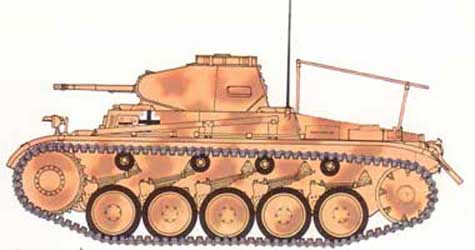 |
Pz-Beobachtungswagen II Ausf.C
|
src: Connaissance de l'Histoire (Hachette)
- HS n°3 - Blindés des origines à 1940
|
Le Schwimmpanzer II II était un char amphibie muni de dispositifs de flottaison installés sur les côtés et l'avant. Toutes les ouvertures étaient hermétiques. Il fut conçu en vue de l'opération Lion de Mer (Seelöwe), l'invasion de l'Angleterre. Il pouvait se mouvoir à une vitesse de 10 km/h en immersion. 52 furent convertis par Alkett et utilisés par le 18e régiment de Panzer dans le secteur central en Russie en 1941.
En janvier 1942, 2 Pz.Kpfw II Ausf.G (VK 901) furent équipés du canon de 50 mm Pak 38 L/60 et testés sur le front est.
En 1942, Skoda produisit son propre Panzer II, dénommé T-15 mais celui-ci entrait en compétition avec le Lynx (VK 1303) et fut abandonné.
Un Pz.Kpfw II Ausf.J fut converti en 1944 en Bergepanzer II Ausf.J sur le front ouest.
On pensa réaliser à partir du Lynx un Bergepanzer Luchs mais l'idée ne fut jamais concrétisée. Le Lynx fut également pressenti pour servir de base pour un Flakpanzer Luchs armé du 20 mm Flakvierling ou du 37 mm Flak 36 mais le projet ne fut pas réalisé.
Schwimmpanzer II II was an amphibious tank provided with floating devices installed on the sides and the front. All the openings were hermetic. It was conceived for the operation Sea lion (Seelöwe), the invasion of England. It could be driven at 10 km/h in immersion. 52 were converted by Alkett and were used by the 18th regiment of Panzer in the central sector in Russia in 1941.
In January 1942, 2 Pz.Kpfw II Ausf.G (VK 901) were equipped with the gun of 50 mm Pak 38 L/60 and tested on the Eastern front.
In 1942, Skoda produced its own Panzer II, called T-15 but this one entered in competition with Lynx (VK 1303) and was abandoned.
One Pz.Kpfw II Ausf.J was converted in 1944 in Bergepanzer II Ausf.J on the western front
One thought of carrying out starting from the Lynx, a Bergepanzer Luchs but the idea was never concretized. The Lynx was also had a presentiment of to be used as a basis for Flakpanzer Luchs armed with the 20 mm Flakvierling or of the 37 mm Flak 36 but the project was not carried out.
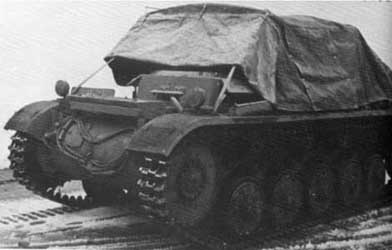 |
Pionierpanzer II |
src: Site Lexikon
der Wehrmacht
|
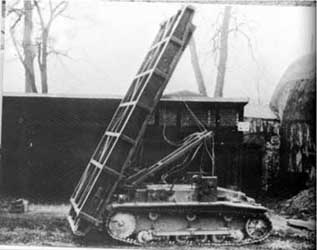 |
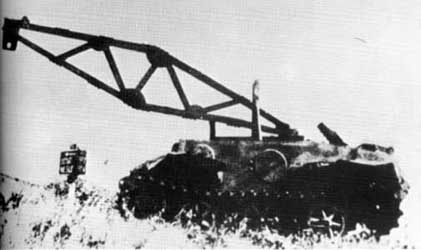 |
Brückenpanzer II
|
Brückenpanzer VK 1601 |
src: Site Lexikon
der Wehrmacht
|
|
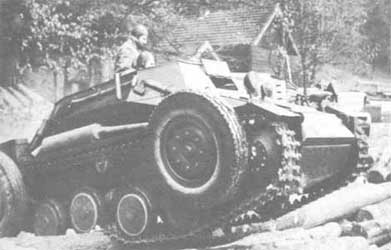 |
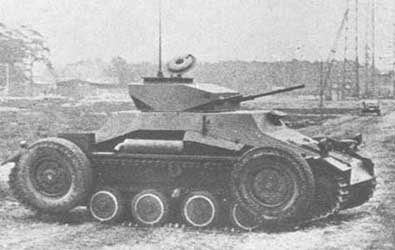 |
RK-9-1
|
RK-9-2 |
src: site Photos
Gallery of WW2
|
|
Autres conversions:
- Beobachtungspanzerwagen II: poste de commandement mobile
- Munitionsschlepper II: transport de munitions
- Brückenleger auf Pz.kpfw II Ausf.B: poseur de pont léger (3 produits en 1939)
- Bergepanzer II Ausf.D/E: char de récupération
- Ladungsleger II: char poseur de charges explosives
- Panzer Beobachtungswagen II: char d'observation pour l'artillerie
- Pioner-Kampfwagen II/Pz.Kpfw II phne Aufbau: véhicule de génie
- Feuerleitpanzer II: véhicule de commande de tir
- Marder II Ausf.A/B/C/F: Chasseur de char avec 75 mm Pak 40 L/46
- Marder II Ausf.D/E: Chasseur de char avec 76.2 mm Pak 36(r) L/51.5
- Sturmpanzer II Bison: Obusier d'assaut armé du 15cm sIG 33(Sf)
- leichte Panzerhaubitze auf GW II Wespe (Sd.Kfz.124): Obusier automoteur armé avec le 105 mm leFH 18(Sf) L/28
Other conversions:
- Beobachtungspanzerwagen II: mobile command station
- Munitionsschlepper II: ammunition carrier
- Brückenleger auf Pz.kpfw II Ausf.B: light bridge layer (3 built in 1939)
- Bergepanzer II Ausf.D/E: recovery vehicle
- Ladungsleger II: explosive loads layer
- Panzer Beobachtungswagen II: artillery observation tank
- Pioner-Kampfwagen II/Pz.Kpfw II phne Aufbau: pioneer vehicle
- Feuerleitpanzer II: fire command vehicle
- Marder II Ausf.A/B/C/F: Tank destroyer with 75 mm Pak 40 L/46
- Marder II Ausf.D/E: Tank destroyer with 76.2 mm Pak 36(r) L/51.5
- Sturmpanzer II Bison: Assault howitzer armed with 15cm sIG 33(Sf)
- leichte Panzerhaubitze auf GW II Wespe (Sd.Kfz.124): Self-Propelled howitzer armed with the 105 mm leFH 18(Sf) L/28
Drawings |
Sources:
- Connaissance de l'Histoire (Hachette) - HS n°3 - Blindés des origines à 1940
- Connaissance de l'Histoire (Hachette) - N°17 - " Les chars de combat allemands 39-45"
- Connaissance de l'Histoire (Hachette) - N°5 - " Véhicules blindés allemands 39-45"
- Les Blindés de la Seconde Guerre Mondiale (Atlas)
- German light panzers 1932-1942 (Osprey Military) - New Vanguard N°26
- Panzer II - Horst Scheibert, Schiffer Military History
- Site "Achtung Panzer" - http://www.achtungpanzer.com
- Site "Germany's vehicle history" - http://www.wwiivehicles.com
- Site "Second World War Armour" - http://www.onwar.com/tanks/index.htm
